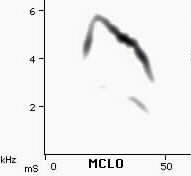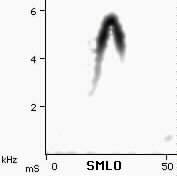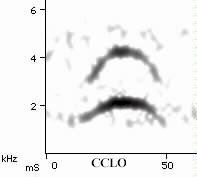


Longspur and Snow Bunting rattles
with Brown-headed Cowbird for comparison
Snow Bunting and four species of Longspurs frequently give similar-sounding rattle calls in flight. Below are some tips for identifying these species by their rattles. The table lists the approximate high frequency of the rattle for each species and the approximate length of a typical individual note within the rattle. Spectrograms illustrate distinctive shapes of these individual notes, and the discussion below puts the information together to reveal how the rattles can be distinguished in the field.
| Rattle call | High frequency (approximate) | Duration of individual notes (approximate) |
| Smith's Longspur | ~5.6 kHz | ~13 mS |
| Lapland Longspur | ~4.5 kHz | ~18 mS |
| Snow Bunting | ~4.0 kHz | ~26 mS |
| Chestnut-collared Longspur | ~2.1 k | ~35 mS |
| McCown's Longspur | ~5.7 kHz | ~28 mS |
| Brown-headed Cowbird | ~4.5 kHz | ~20 mS |
Smiths Longspur The easiest of the four species' rattles to distinguish. It is the highest-pitched, and the individual notes are significantly shorter than those of the other species. The spectrogram reveals that the individual notes have a greater period of ascent in the beginning than descent at the end. This aspect is hard to hear because the energy of the call is concentrated in a short period of equal ascent and descent. The result is a quick dry rattle, more mechanical and less musical than the other species. It is a rapid series of high "spit" notes, often up to 6 or 7 in a series. The series as a whole is typically descending, sometimes with the last note distinctly lower.
Lapland Longspur Its high frequency is significantly lower than McCown's, but the frequency distribution of energy in the two species' rattles is fairly similar. This is because energy in Lapland's rattle is concentrated in the highest frequency portion of its call, whereas McCown's energy is centered in the middle portion of its call. This brings the frequency of the two rattles closer together and makes distinguishing them by pitch alone difficult. A better clue is the length of the individual notes and the corresponding degree that the individual notes seem to descend. The shorter, less descending notes of Lapland sound more distinct and drier, not slurred or squeaky. Lapland's rattle is distinctly more musical and lower-pitched than Smith's. It often gives 3-5 notes in a series but seems rarely to give 6-7 like Smith's does.
Snow Bunting This species has the lowest-pitched rattle, but it is close enough to Lapland and McCown's that it is difficult to discriminate these three species by pitch alone. The structure of the individual notes gives some identification help. Lapland's individual notes have a quick descending sound, while Snow Bunting's have a stronger rising component. Snow Bunting's notes are significantly longer than Lapland's, giving the rattle a somewhat fuller and richer-sounding quality. The number of notes per rattle does not yield clues for discriminating Lapland and Snow Bunting rattles.
Chestnut-collared Longspur This species' rattle is unique in being much lower-pitched and with longer individual notes within the rattle. It sounds closest to Snow Bunting's rattle but is softer and more slurred. It is also not known to be given by itself, only in sequence with other notes that are distinctive to Chestnut-collared. Chestnut-collared also apparently gives a short rattle on the breeding grounds. The notes in this short rattle are higher-pitched but more closely-spaced giving this rattle a distinctive sound.
McCown's Longspur Nearly as high-pitched as Smith's, but the length of the individual notes within the rattle averages more than twice as long in duration. Also, as can be seen in the spectrograms above, the individual notes of McCown's are largely descending. This results in a much more expressive, more musical rattle than Smith's, with a lower-pitched sound than either Smith's or Lapland Longspurs. The descending individual notes seem to run together and give the rattle a squeaky quality. McCown's seems to rarely have more than 4 notes per rattle.
Brown-headed Cowbird This species' rattle is typically longer than any longspur's rattle and it usually increases in loudness and pitch, unlike longspur rattles. Shorter calls, however, may be very similar to Lapland Longspur's and Snow Bunting's rattles.